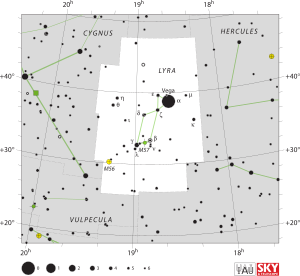HIP 94292
| Observation data Epoch J2000.0[1] Equinox J2000.0[1] | |
|---|---|
| Constellation | Cygnus |
| Right ascension | 19h 11m 32.53446s |
| Declination | +45° 31′ 22.6081″ |
| Apparent magnitude (V) | 10.05[2] |
| Characteristics | |
| Evolutionary stage | Red-giant branch star |
| Spectral type | G8III[3] |
| B−V color index | 0.90[2] |
| J−H color index | 0.474[4] |
| J−K color index | 0.549[4] |
| Astrometry | |
| Radial velocity (Rv) | 17.408899±0.007546[5] km/s |
| Proper motion (μ) | RA: 3.138[1] mas/yr Dec.: −15.988[1] mas/yr |
| Parallax (π) | 2.4141 ± 0.0098 mas[1] |
| Distance | 1,351 ± 5 ly (414 ± 2 pc) |
| Details[6] | |
| Mass | 1.24 M☉ |
| Radius | 5.636 R☉ |
| Luminosity | 18.759 L☉ |
| Surface gravity (log g) | 3.029 cgs |
| Temperature | 5069 K |
| Metallicity [Fe/H] | −0.32±0.03[7] dex |
| Age | 4.61±0.23[8] Gyr |
| Other designations | |
| Database references | |
| SIMBAD | data |
HIP 94292, commonly referred to by its KIC designation KIC 9145955, is a red-giant branch star located in the northern constellation of Lyra.
Description
[edit]It has an apparent magnitude of 10.05,[2] which makes it too faint to observe with the naked eye, but readily visible through a 35-mm aperture telescope.[9] Gaia EDR3 parallax measurements place the star some 1,351 light-years (414 parsecs) distant, and it is receding with a heliocentric radial velocity of +17.4 km/s.[1]
HIP 94292 is an evolved giant star with a spectral type of G8III.[3] It is currently on the red-giant branch (RGB),[6] undergoing the CNO cycle within a hydrogen shell surrounding an inert core made of helium. With a radius 5.6 times that of the Sun and an effective temperature just over 5,000 K (4,730 °C; 8,540 °F), it radiates 18.8 times the luminosity of the Sun from its photosphere.[6] Due to its higher mass of 1.24 M☉, it is further evolved than the Sun despite a similar age of 4.61±0.23 billion years.[8]
The helium core has been precisely measured to have a mass of 0.210±0.002 M☉ and a radius of 0.0307±0.0002 R☉.[6] As expected of RGB stars, HIP 94292 exhibits solar-like oscillations.[8]
See also
[edit]- KIC 9970396: a similar red giant in an eclipsing binary.
References
[edit]- ^ a b c d e Brown, A. G. A.; et al. (Gaia collaboration) (2021). "Gaia Early Data Release 3: Summary of the contents and survey properties". Astronomy & Astrophysics. 649: A1. arXiv:2012.01533. Bibcode:2021A&A...649A...1G. doi:10.1051/0004-6361/202039657. S2CID 227254300. (Erratum: doi:10.1051/0004-6361/202039657e). Gaia EDR3 record for this source at VizieR.
- ^ a b c Høg, E.; et al. (February 2000). "The Tycho-2 Catalogue of the 2.5 Million Brightest Stars". Astronomy and Astrophysics. 355 (1): L27 – L30. Bibcode:2000A&A...355L..27H.
- ^ a b Molenda-Zakowicz, J.; et al. (December 2008). "Spectroscopic Study of Candidates for Kepler Asteroseismic Targets - Solar-Like Stars". Acta Astronomica. 58: 419. arXiv:0907.0816.
- ^ a b c "BD+45 2850". SIMBAD. Centre de données astronomiques de Strasbourg. Retrieved 24 October 2024.
- ^ Jönsson, Henrik; et al. (17 August 2020). "APOGEE Data and Spectral Analysis from SDSS Data Release 16: Seven Years of Observations Including First Results from APOGEE-South". The Astronomical Journal. 160 (3). American Astronomical Society: 120. arXiv:2007.05537. doi:10.3847/1538-3881/aba592. ISSN 0004-6256.
- ^ a b c d Zhang, Xinyi; et al. (28 February 2018). "Frequency Identification and Asteroseismic Analysis of the Red Giant KIC 9145955: Fundamental Parameters and Helium Core Size". The Astrophysical Journal. 855 (1). American Astronomical Society: 16. arXiv:1802.01320. doi:10.3847/1538-4357/aaaabb. ISSN 0004-637X.
- ^ Pérez Hernández, F.; García, R. A.; Corsaro, E.; Triana, S. A.; De Ridder, J. (21 June 2016). "Asteroseismology of 19 low-luminosity red giant stars from Kepler". Astronomy & Astrophysics. 591. EDP Sciences: A99. arXiv:1605.01567. doi:10.1051/0004-6361/201628311. ISSN 0004-6361.
- ^ a b c Zhang, Xinyi; et al. (1 May 2022). "Determining the Age for the Red Giants KIC 9145955 and KIC 9970396 by Gravity-dominated Mixed Modes". The Astrophysical Journal. 931 (1). American Astronomical Society: 64. doi:10.3847/1538-4357/ac695b. ISSN 0004-637X.
- ^ North, Gerald; et al. (2014). Observing Variable Stars, Novae and Supernovae. Cambridge University Press. p. 24. ISBN 978-1-107-63612-5.

